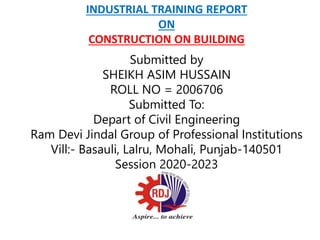
SHEIKH ASIM HUSSAIN.pptx
- 1. INDUSTRIAL TRAINING REPORT ON CONSTRUCTION ON BUILDING Submitted by SHEIKH ASIM HUSSAIN ROLL NO = 2006706 Submitted To: Depart of Civil Engineering Ram Devi Jindal Group of Professional Institutions Vill:- Basauli, Lalru, Mohali, Punjab-140501 Session 2020-2023
- 2. INTRODUCTION Why do we need buildings? Departments need more constraints on building construction Cycle Process of building construction Elements create building loading Forces delivered to earth for building to be structurally sound Basic building confonent Identify construction materials
- 3. Why do we need buildings? We need shelter from sun, wind, rain, and snow. We need dry, level platforms for our activities. we need to stack these platforms to multiply available ground space. On these platforms, and within our shelter, we need air that is warmer or cooler, more or less humid, than outdoors. We need less light by day, and more light by night, than is offered by the natural world. We need services that provide energy, communications and water and disposal of wastes. So we gather materials and assemble them into the constructions we call buildings to satisfy these needs.
- 4. Constraints on building construction Health codes : Occupational health and safety Fire codes Plumbing codes Electrical codes Building Contractors’and Labor Unions’Regulations
- 5. Cycle process of building construction The main stages are: 1: Planning 2: Design 3: Tendering 4: Construction Process 5: Handover 6: Evaluation
- 6. Elements create building loading Various loads are taken into account while designing the foundation of a structure loads coming on a structure are: Two broad categories: - Dead loads - Live loads Specific terms for dead loads and live loads: -Concentrated load - Distributed load - Design load - Undesigned load -Fire load
- 7. Imposition of Loads Loads must be transmitted to structural elements Terms associated with imposition: – Axial load – Eccentric load – Torsion load
- 8. Structural Elements Buildings are an assembly of structural elements designed to transfer loads to the earth Can be defined simply as: – Beams – Columns – Walls – Connections
- 9. Beams Transfers loads perpendicular to its length Types of beams: – Simple beam – Continuous beam – Cantilever beam – Lintel – Girder – Joist – Truss and Purlin
- 10. Columns Any structural component that transmits a compressive force parallel through its center Typically support beams and other columns Generally vertical supports of building Can be vertical, horizontal, or diagonal
- 11. Walls Really long, but slender, column Two categories: – Load-bearing walls • Carries weight of beams, other walls, floors, roofs, other structural elements • Also carries weight of the wall itself – Non-load-bearing walls • Need only support its own weight • Example: partition wall between two stores in a strip mall
- 12. Connections Weak link as it relates to structural failure during fires – Often small, low-mass material that lacks capacity to absorb heat Three categories: – Pinned – Rigid – Gravity
- 13. Basic building components SUPER STURCTURE Plinth D.P .C Walls and colums Floors Beams Roofs and slabs Lintels andAechers Doors and Window Chajjas Parapet Steps and Stairs Cupboard and Shelves Substructer Foundatio n
- 14. Identify construction materials Many factors determine which material is used to form structural elements: – Cost – Application – Engineering capabilities – Adaptability Each material reacts to fire in a different way
- 15. Wood Most common building material Relatively inexpensive Marginal resistance to forces compared to weight Native wood with more mass takes longer to burn before strength is lost Engineered wood – Plywood delaminates when exposed to fire – Some composites fail through exposure to heat without burning
- 16. Steel Mixture of carbon and iron ore Excellent tensile, shear, and compressive strength Popular choice for: – Girders – Lintels – Cantilevered beams – Columns Loses strength as temperatures increase
- 17. Concrete Mixture of portland cement, sand, gravel, and water Excellent compressive strength All concrete contains some moisture Under heat, moisture expands and causes concrete to crack and spall Concrete can stay hot long after the fire is out
- 18. Masonry Common term that refers to brick, concrete block, and stone Used to form load-bearing walls Veneer wall supports its own weight Mortar holds units together and have little or no tensile or shear strength Excellent fire-resistive qualities
- 19. Cement Mixture of calcium silicates and aluminium cilicates and aluminium ferrite It is give good compressive strength It have good setting time It is hygroscopic material We use as binding material
- 20. Work at Site